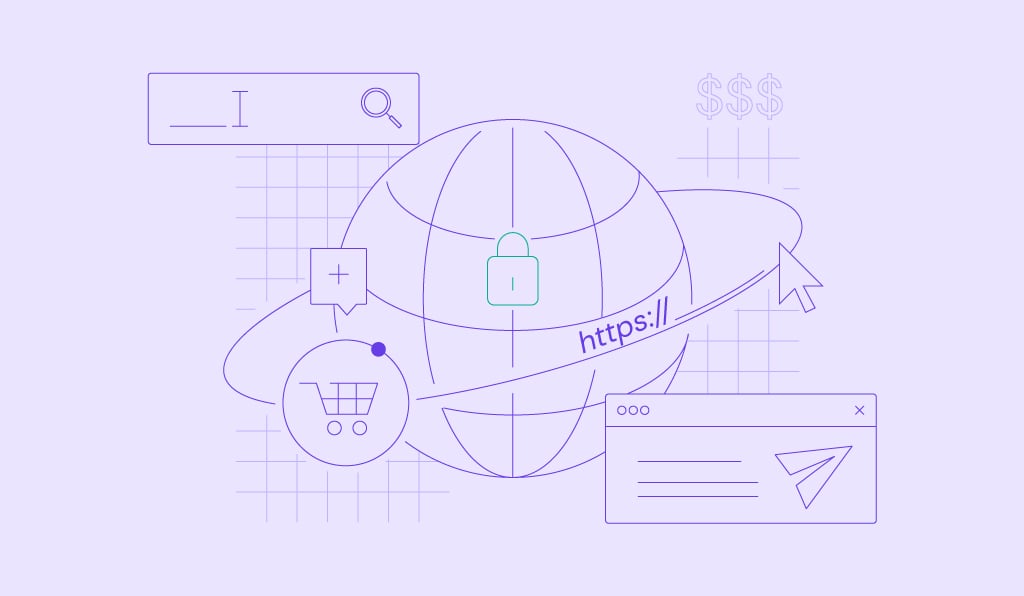How to make money on Instagram in 2025
With over 2 billion monthly users, Instagram is a marketing goldmine. In fact, according to Statista, 79% of marketers call it their favorite platform. But here’s the cool part ‒ you can also make money on Instagram just like your favorite creators.
Whether you’re a small business or an aspiring content creator, there are different ways of making money on Instagram. Stick around ‒ we’ve got 10 ideas to help you grow your income, plus some tips to get started.
10 ways to make money on instagram
1. Start affiliate marketing
When you catch an Instagram creator asking their followers to click a link, you’re likely seeing this business model in action.
With affiliate marketing, you receive a commission for promoting someone else’s product to your audience. So, when someone buys through your affiliate link, you earn a percentage or flat rate of the sale (depending on the commission structure).
This is how Chaitra and Sunkist (@madoverexploring) earn money from their Instagram creator account. The couple shares Instagram posts and stories about their adventures as travel vloggers, adding affiliate links so their audience can book the places they visit.
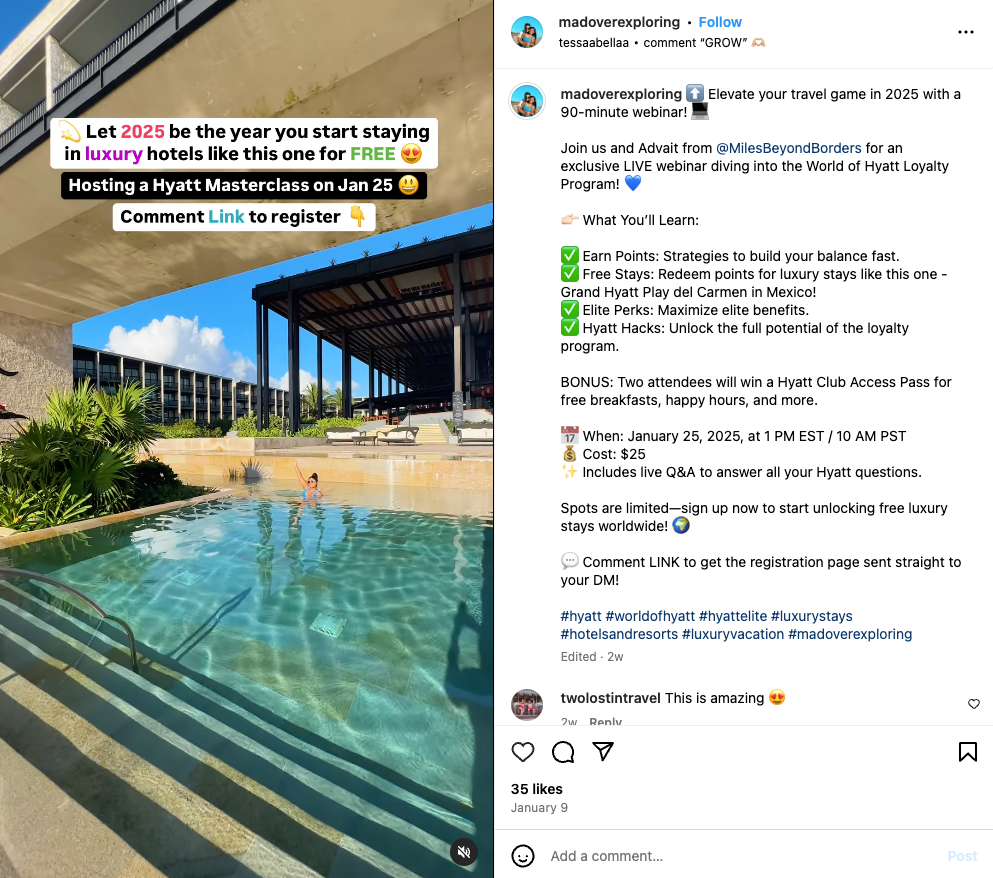
You can start by joining popular affiliate marketing programs in your niche. Create content that resonates with your followers’ interests and include affiliate links in your Instagram post captions, stories (using the Swipe Up feature), and reels.
However, unlike digital marketing, affiliate marketing relies heavily on affiliates’ audience. To generate revenue faster, focus on growing your Instagram followers first. Having an audience also increases your chances of qualifying for high-paying affiliate programs and earning more per sale.
Check out our article to see how much affiliates actually make. We also wrote an article covering the best affiliate marketing niches to set yourself up for success.
Did you know?
The average affiliate marketer makes $8,038 per month. Boost your earnings by creating an affiliate marketing website.
2. Sell products
Got your own products to promote? No problem ‒ set up Instagram Shopping to let your audience buy directly from your account or redirect them to your website.
Integrating your store with Instagram makes it super easy for people to buy on impulse. You can tag products in post captions, stories, and reels to help Instagram users find and buy them.
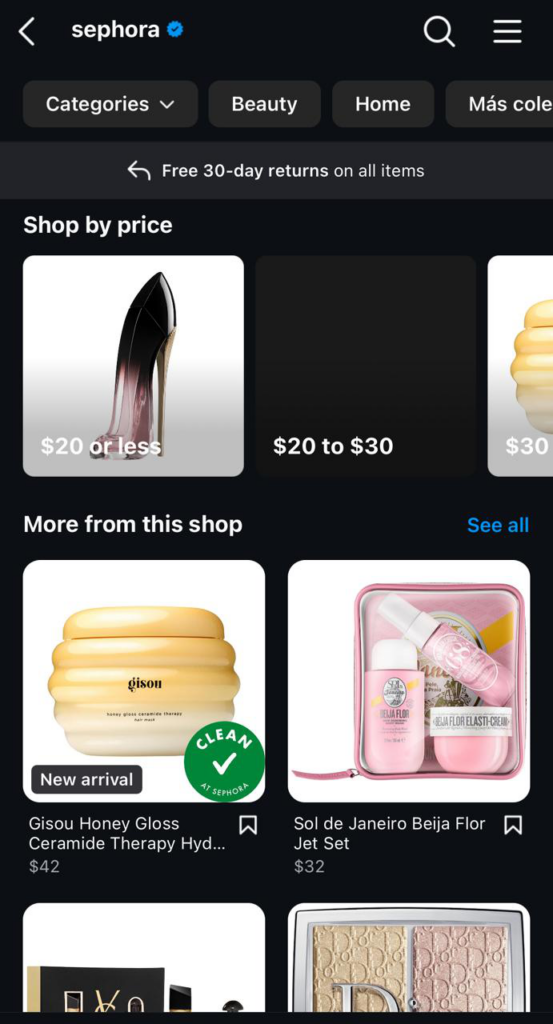
However, Instagram Shop is currently only available in certain countries. What’s more, only sellers in North America can use Instagram Checkout to accept purchases through the app instead of just browsing products.
Another option is to set up your own online store and promote it on Instagram. You’ll also have total control over your store’s look and feel, which is great for long-term branding.
Hostinger’s Business and all cloud hosting plans can help you start a website hassle-free. Starting at ₹249.00/month, our plans include an AI-powered website builder to get your site up and running in no time ‒ no coding required.
You also get AI-powered tools to streamline various tasks ‒ craft unique product descriptions, create unique visuals, make the site search engine-friendly, and more.
Buy an annual plan and get a free one-year website domain to improve your branding game.
3. Sell digital products
If managing physical products feels like a hassle, try selling digital products instead. Convert your skills into downloadables like ebooks, music files, and online courses and generate recurring income from them ‒ no inventory or shipping needed.
This is how Maggie Waters (@itslifebymaggie) makes a living on Instagram. After getting into medical school, she started offering workshops on navigating premed life while maintaining her course’s original values.
“My main revenue stream from Instagram is my online course Road to Acceptance. I promote a free workshop through my Instagram posts and stories, which include a special offer for the course,” Maggie tells us.
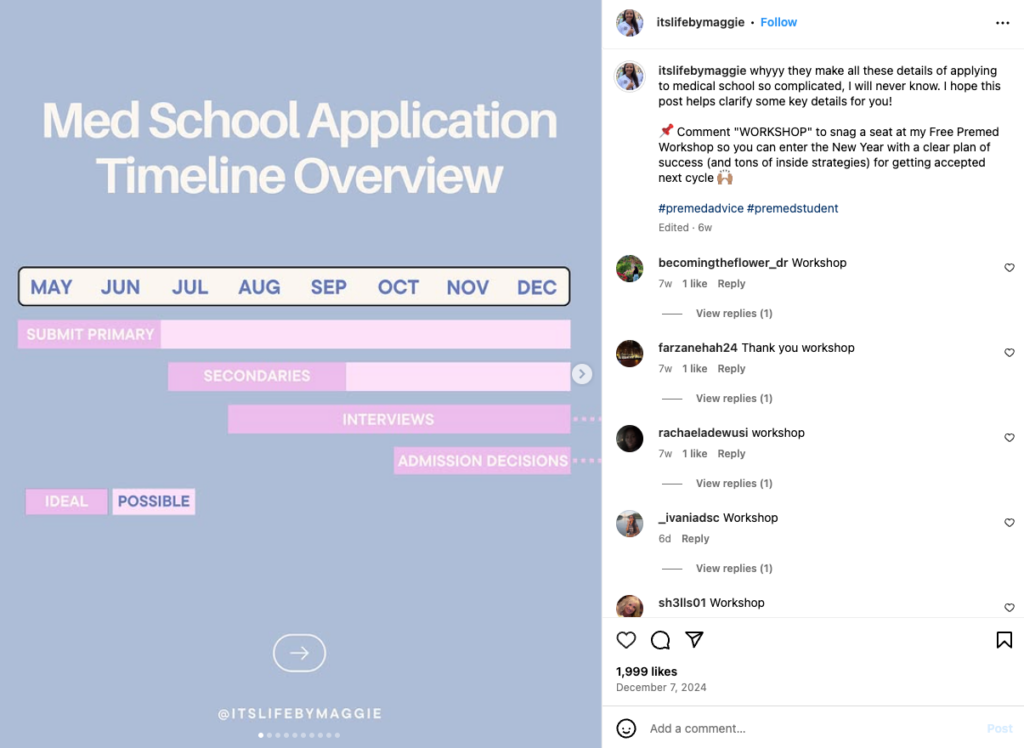
Many third-party platforms offer tools to make selling certain digital products easy, like OFFstep for audio files and Amazon Kindle Direct Publishing for ebooks. However, they usually charge a commission per sale, affecting your total revenue.
Content creators can get the best of both worlds by hosting their downloadables on these platforms and their own sites. Chaitra and Sunkist, for example, cater to their audience’s split preferences by hosting content on madoverexploring.com and Thatch.
“While people can visually see what we did through YouTube videos or Instagram Reels, they still want detailed information about the trip laid out in a written format, along with links, references, and so on. So, the tool really helps me put all those recommendations in one place. It works kinda like an ebook, so we can also sell it as a digital product,” says Chaitra.
Or, do what Maggies does ‒ make the most of your website by using Instagram’s huge user base to drive traffic.
“I mainly get new students from Instagram. But I also attract some leads to my freebies and online courses by consistently publishing blog posts on my website itslifebymaggie.com,” Maggie shares.
Check out our article on selling online courses for tips and best practices.
4. Publish sponsored posts and stories
Sponsored Instagram posts and stories are like affiliate marketing, but you get paid a fixed amount to promote a product even if no sales are made.
Since this business model focuses on brand exposure rather than purchases, it’s more common among top-tier creators with an established following. Partnering with creators who share a target audience helps brands reach more people and boost sales.
You can usually tell an Instagram post or story is sponsored if it has an #ad or #sponsored in the caption, though not all countries require creators to share that information. Or, like Mark Fischbach (@markiplier), the creator must add the Paid Partnership tag to sponsored post captions.
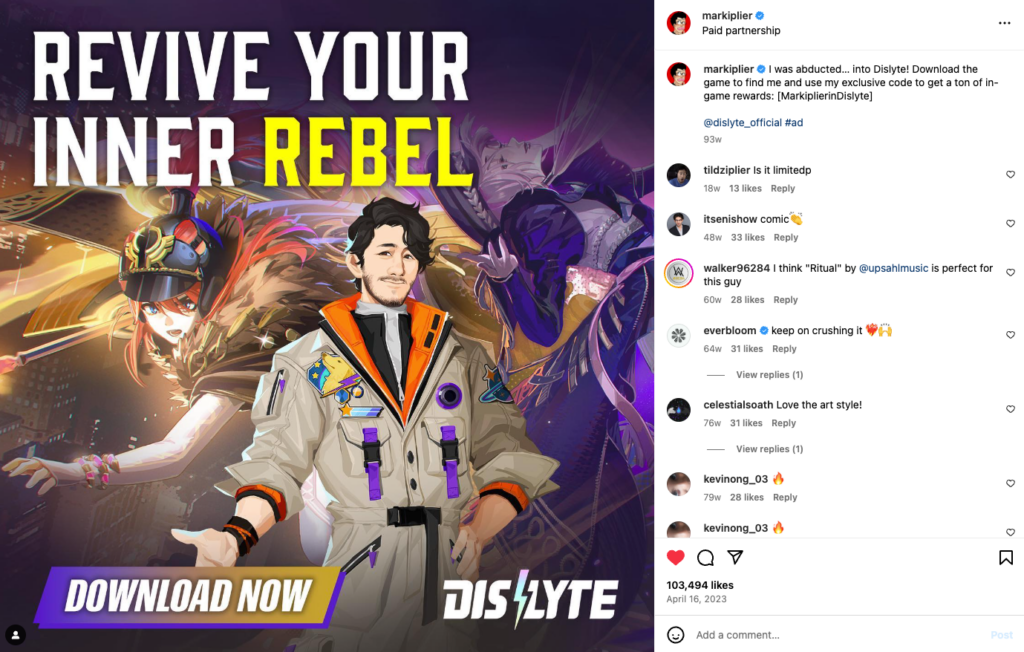
For the best results, it’s important to partner with companies in your niche. If you promote something that resonates with you and your audience, your post will look more genuine. After all, you’d trust your favorite creator over a brand, right?
5. Offer paid subscriptions
Want to make a recurring income while building a deeper connection with your loyal followers? Enable Instagram Subscriptions.
Followers can pay a monthly subscription fee to support their favorite creators. In return, they get access to exclusive content, subscriber-only group chats, and a subscriber badge next to their username.
To set up a subscription system, you need to have an Instagram business or creator account with at least 10,000 followers.
There’s no extra cost, and you keep 100% of the revenue from subscriptions bought during Instagram Live (minus taxes or fees). However, Google and Apple take 30% off in-app purchases.
As for the content? That’s up to you! Cafe Maddy (@cafemaddy), for example, offers exclusive home cooking and daily life content, as well as access to a subscriber-only group chat.
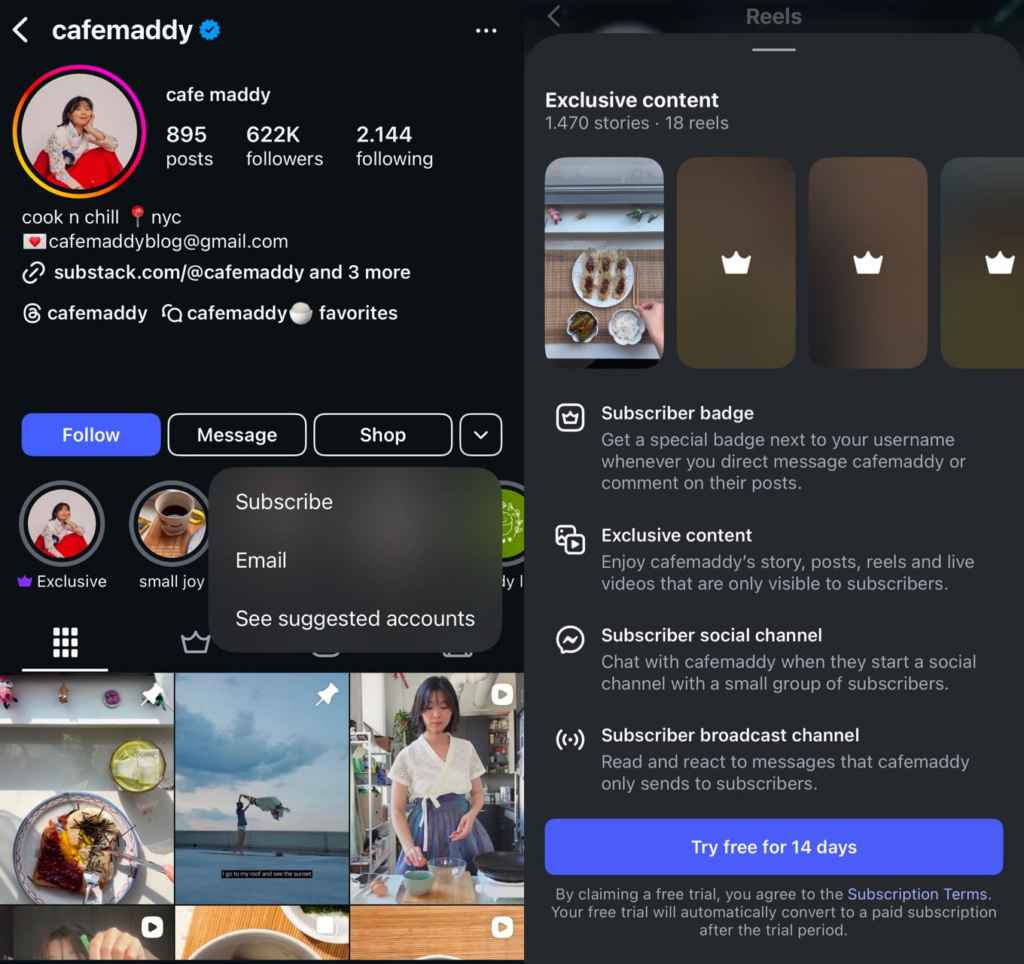
Here are more content ideas for inspiration:
- Q&A. Answer people’s questions or ask them how they’re doing. This is a great way to show your authenticity and build trust with your subscribers.
- Behind-the-scenes. Creating content regularly takes effort, so why not share your process with those consuming it for extra dollars? You can even share funny bloopers that don’t make the final cut.
- Personalized message. Let your followers request a birthday message or positive encouragement for themselves or a loved one.
- Upcoming content. Drop hints on upcoming projects and give your followers early access.
- User-generated content. Share your followers’ creative work to give them recognition and a sense of belonging in your community.
6. Collaborate with other creators
Have you ever seen different creators make content together? They might be friends off camera, but there are also benefits to teaming up with other Instagram creators.
The first one is brand exposure. Collaborating with a creator in your niche expands your audience of like-minded people. This helps boost visibility, growth, and engagement ‒ key factors to making the other monetization methods on this list work.
Collaborating with other creators also encourages an exchange of ideas and knowledge. By working together, creators can share techniques, insights, and strategies that have worked for them.
And let’s not forget the opportunity to make new friends and have fun!
You can use Instagram Collabs to co-author posts with another creator and display them on both accounts. Don’t forget to tag each other when sharing with your followers.
Collabs don’t have to be elaborate to be engaging. For example, Ashley Yi (@ashyi) and fellow creator Jeenie Weenie (@jeenie.weenie) made their trip to a 7-Eleven in Korea fun and relatable by trying new things while tackling the language barrier.
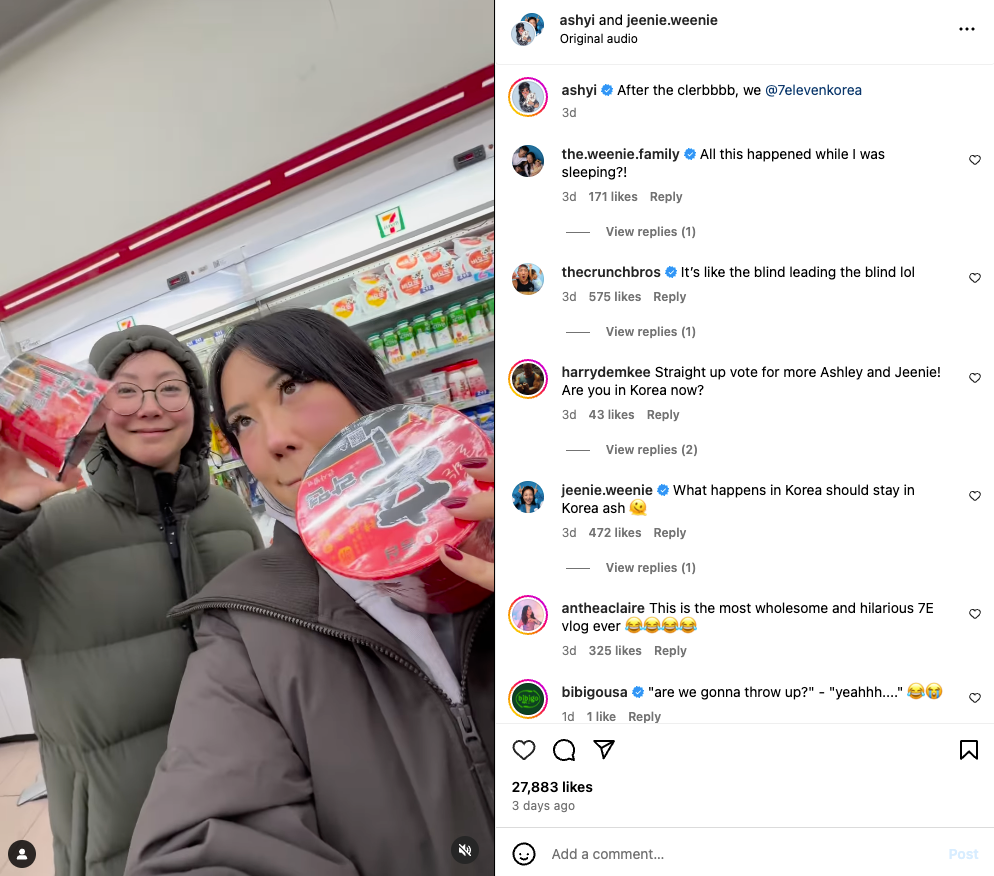
7. Host giveaways
Who doesn’t love freebies? Most creators have done a giveaway at some point because it’s great for driving engagement and follower count.
The host usually requires Instagram users to do certain things in order to enter, such as liking or commenting on the post, following the account, or tagging some friends.
You can prepare the prize yourself or team up with a brand and let them handle it for you. It’s a win-win ‒ the brand gets access to your audience, and you get engagement (and maybe new followers) without spending a dime.
Take Alyshia Jones-Mathie (@alyshiajoness) as an example. She partnered with Megan Fairley Chocolate Queen (@meganfairley_chocolatequeen) to give away chocolate gift boxes for Christmas.
To enter the draw, users must follow both accounts, tag a friend, and share the post on their Instagram story. To increase their chance of winning, they could tag multiple friends and subscribe to Alyshia’s YouTube channel. That’s a lot of potential engagement from just one giveaway!
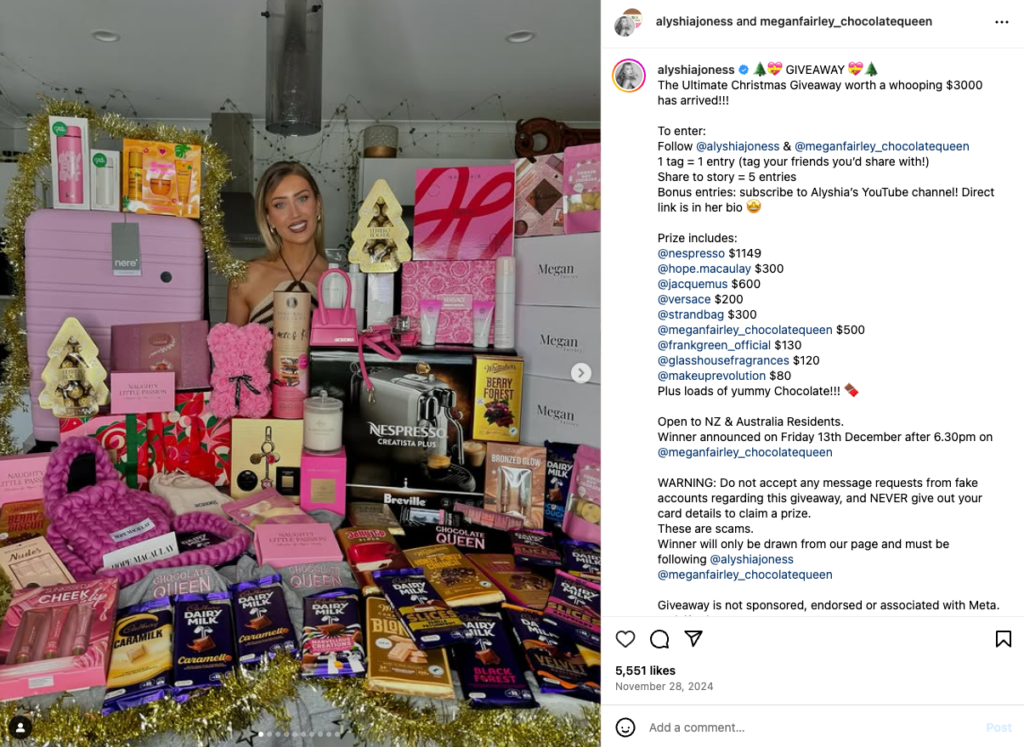
The key to hosting a successful giveaway is the prize, so collaborate with a brand relevant to your target audience. The right prize will bring in more entries and strengthen your partnership with the brand sponsoring the event.
Most importantly, make sure to follow Instagram’s promotion guidelines to avoid being penalized, suspended, or shadowbanned by the platform.
A good rule of thumb is to state that Instagram doesn’t sponsor or endorse your giveaway. Also, share all the key details about the event, including the dates (and timezone), terms and conditions, and how the winner will be chosen.
8. Promote freelance services
Besides selling digital products, another way to monetize your skills is by offering freelance services. Turn your Instagram account into an online portfolio to showcase your work.
You can turn almost any niche into Instagram content. Manuel Medina (@hands_on_lens) showcases his photography skills. Meanwhile, Jenn Mullen (@mindfulvirtualassistant) promotes her virtual assistant services by sharing photos of herself working, motivational quotes, and her favorite work tools.
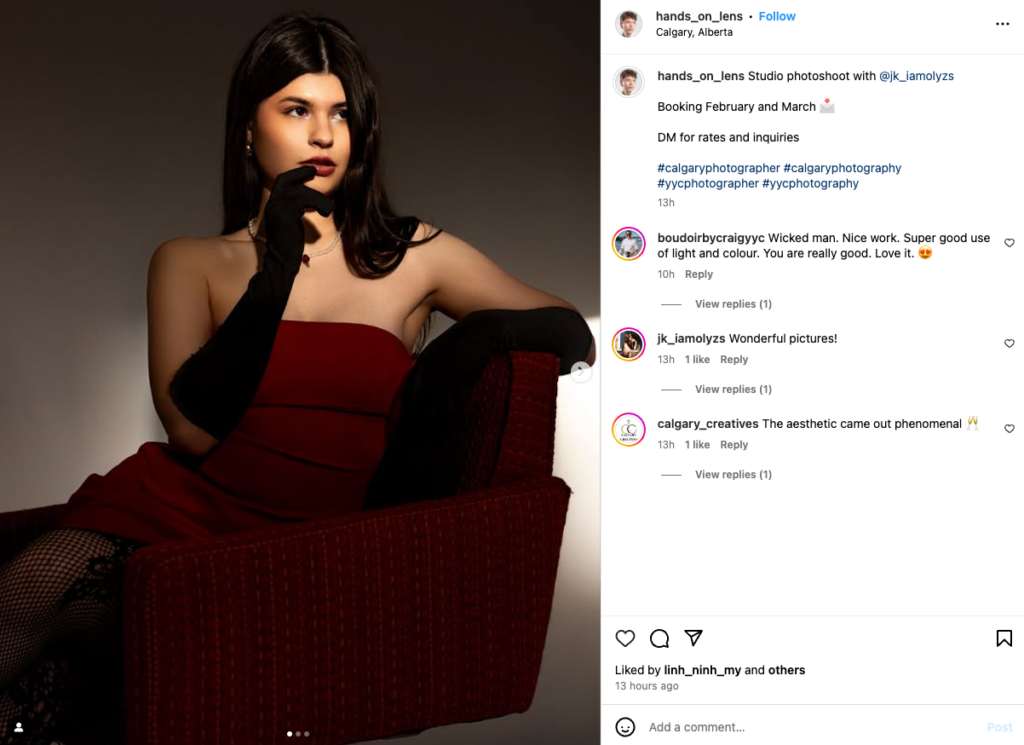
Many freelancers use Instagram purely for promotional purposes and conduct their business privately via DMs, email, or other communication methods. Some prefer using freelance platforms like Fiverr or Upwork. Whichever way you prefer, be sure to mention it on posts and in your bio.
The same goes for how you want potential clients to book your services. For example, Manuel might be cool with direct messages (DM), but Jenn prefers directing potential clients to her website to reach out via a contact form. Maybe you prefer to make contact by email?
Don’t forget to add relevant hashtags to your post to boost their visibility. If you’re targeting people in a certain area, include it in the hashtags. Manuel nails it with his use of #calgaryphotography and #calgaryphotographer.
9. Advertise events or webinars
Instagram’s massive reach makes it valuable for promoting events, from educational webinars to live Q&As and concerts. Whether you’re promoting your own event or someone else’s, you can monetize it with the right approach.
Start by sharing all the details about your event – who it’s for, how it’ll help attendees (if applicable), the date, time, and anything else they need to know.
Take inspiration from Rebecca Eldridge (@hellohappyhormonesclub) and how she promotes her group sessions for women with Premenstrual Dysphoric Disorder (PMDD).
She shares details about the event, including who it’s for and what to expect ‒ promoting transparency and helping new followers who might want to join.
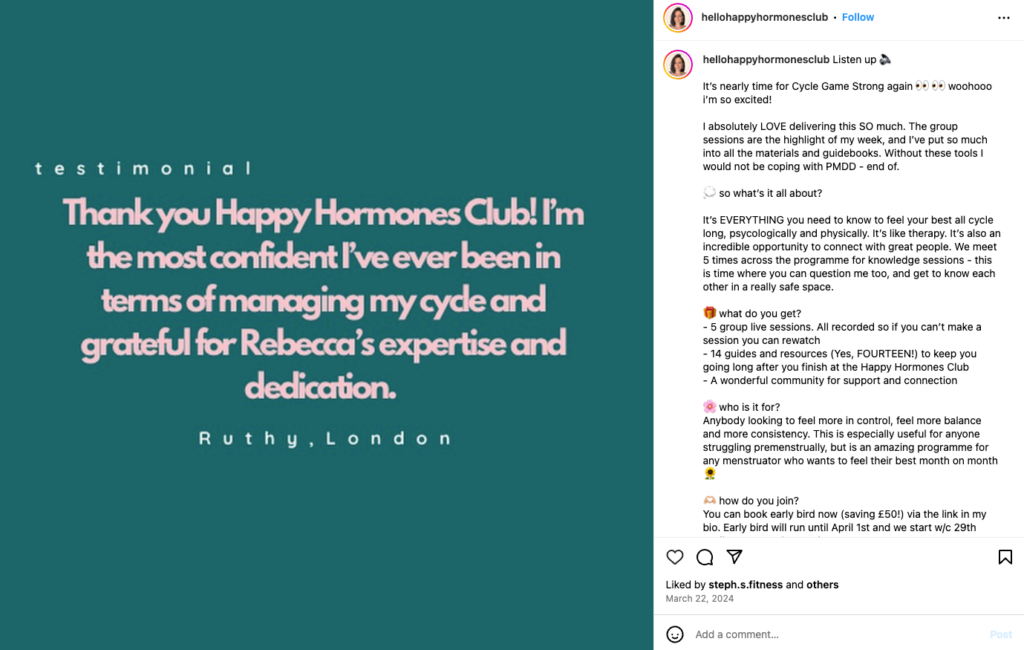
Then, direct people to a website where they can buy tickets or book seats. Since you can’t click a link on an Instagram post caption, it’s better to place it on your bio instead. Or, promote it with an Instagram story and use Swipe Up to attach the link.
Come up with a unique hashtag to increase your promotional posts’ visibility. Your followers can use it to post about the event, which is great for driving user-generated content. Just make sure the hashtag represents your event and is easy to spell.
10. Join brand ambassador programs
Unlike influencers, brand ambassadors usually collaborate with only one brand in a certain niche. The brand purposely finds creators who can best represent their product to serve as a marketing funnel. That’s why these partnerships are usually long-term, starting with the creator genuinely loving the products.
Ryan Leier (@ryanleier) serves as a global ambassador for Lululemon thanks to his passion for yoga, mental health advocacy, and community empowerment. The athletic apparel brand saw Ryan as the nice fit to get its message out, and the rest is history.
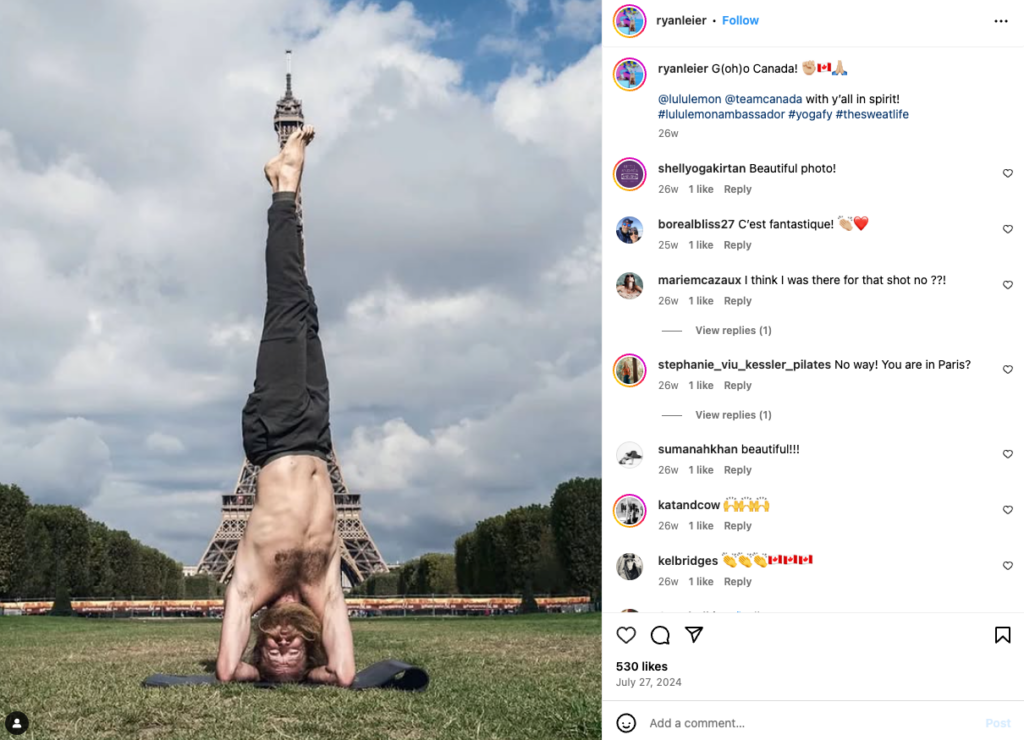
While working with one brand at a time might seem limiting, you can build lasting relationships with brands and get featured by them. These perks can help you build a strong portfolio for future partnerships, boost visibility, and expand your network through events.
And don’t forget the exclusive goodies coming your way!
Follow Ryan’s lead by joining a brand ambassador program in your niche. Consider the rewards before joining ‒ cash, points, discounts, and freebies are the most common.
Once you find the right brand, start creating content about its products and niche. Showing your love for the brand and getting involved in its community helps you stand out. It’s also a great way to grow your own following, something every brand considers when selecting ambassadors.
How much money can I make on Instagram?
According to Influencer Marketing Hub, you can make as little as $5/post when you’re just starting out. The more followers you have, the higher the pay.
Here’s how much Instagram creators earn based on follower count:
- Nano-creators (500-10,000 followers) ‒ $5-25/post
- Micro-creators (10,000-100,000 followers) ‒ $25-125/post
- Mid-tier creators (100,000-500,000 followers) ‒ $125-1,250/post
- Macro-creators (500,000-1 million followers) ‒ $1,250-2,500/post
- Mega-creators (1+ million followers) ‒ $2,500+/post
Remember, these are just rough estimates. Your niche, monetization methods, and marketing efforts can also impact your earnings per post.
How can I grow my followers on Instagram?
By now, you probably understand that the size of your following matters. Here are some strategies Instagram creators swear by to grow followers:
- Add keywords to your name. Help first-time visitors know what to expect from your account. Using keywords relevant to your niche also helps people find you.
- Optimize your Instagram bio. Tell people who you are and what you do in 150 characters. Throw in a call to action and links to your website to drive engagement.
- Create a content calendar. Whether you want to post every day or once a week, consistency is key! For optimal results, try posting during peak times.
- Use reels and carousels. Sure, they take more effort than single-photo posts. However, Buffer claims that reels get 36% more reach, and carousels see 12% higher engagement.
- Cross-promote. Repurpose existing content for other social media channels and see your brand awareness skyrocket with minimal effort. You can then redirect new people from other platforms to your Instagram page and vice versa.
- Focus on creating visually appealing content. Instagram is all about visuals, so make sure your content is worth other users’ time.
- Use hashtags. Add popular and relevant hashtags to your post captions to boost discoverability. Keep it under 5 per post for optimal reach without appearing spammy.
- Invest in Instagram Ads. Not to be confused with buying followers (which can harm your credibility and engagement rate), turning content into ads guarantees visibility when you’re starting out. Be sure to target the right audience and stick to your budget.
- Collaborate with other creators. Partnerships can expand your reach and boost your earning potential by connecting you with new followers. Plus, it doesn’t hurt to make a friend in your niche.
Conclusion
Where there’s fun, there’s money to make – and Instagram’s no different. You can sell pretty much anything on Instagram, from vacation stays to webinar tickets, or team up with brands as an affiliate or ambassador.
Lots of people have even turned their Instagram gig into a full-time job using one or a combination of these methods:
- Start affiliate marketing
- Sell products
- Sell digital products
- Publish sponsored posts and stories
- Offer paid subscriptions
- Collaborate with other creators
- Host giveaways
- Promote freelance services
- Advertise events or webinars
- Join brand ambassador programs
Experiment with different strategies and see what works best for you. With dedication and smart planning, you, too, can join the ranks of successful Instagram creators.
See you at the top!
How to make money on instagram FAQ
Can you get paid from Instagram?
Yes, Instagram actually has monetization programs like Live Badges and View Bonuses. However, you need to hit a certain number of followers and live in a certain region. Also, the pay isn’t as big as platforms like YouTube.
How many followers do you need on Instagram to make money?
There’s no fixed rule. You can get clients with only 100 followers as long as you attract the right audience. However, you usually need 1,000 to 10,000 followers to secure brand collaborations.
How should I price my posts for Instagram sponsorships?
The standard rate is $100 per 100,000 followers. That said, consider factors like your niche, reach, engagement, the number of posts you should make, and production costs when negotiating your rate.





